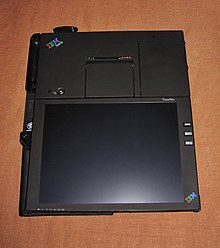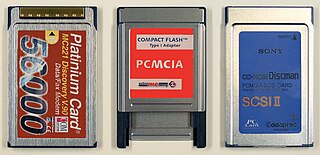
PC Card is a parallel peripheral interface for laptop computers and PDAs.

In computing, an expansion card is a printed circuit board that can be inserted into an electrical connector, or expansion slot on a computer's motherboard to add functionality to a computer system. Sometimes the design of the computer's case and motherboard involves placing most of these slots onto a separate, removable card. Typically such cards are referred to as a riser card in part because they project upward from the board and allow expansion cards to be placed above and parallel to the motherboard.

ThinkPad is a line of business-oriented laptop computers and tablets, the early models of which were designed, developed and marketed by IBM, starting in 1992. In 2005 IBM sold its PC business, including laptops to Lenovo. The Chinese manufacturer further developed the line, and is still selling new models in 2023.

The IBM ThinkPad 701 is a subnotebook in the ThinkPad line by IBM. The 701 is colloquially known as the Butterfly due to its sliding keyboard, which was designed by John Karidis. It was developed from 1993 and sold from March 1995 until later that year and priced between $1,499 and $3,299. The 701 was the most sold laptop in 1995 and has received 27 design awards. It was based on either the DX2 or the DX4 version of the Intel i486, combined with CT-65545 graphics chip from Chips and Technologies. The 701Cs version used a DSTN display, while the 701C used a TFT LCD. It was pre-installed with Windows 3.11 and for the DX4 models also with OS/2 Warp 3.0. The 701 was discontinued because the keyboard design was no longer a necessity after screen sizes increased. After its discontinuation there has been some speculation about a new notebook with a butterfly style keyboard.

Subnotebook, also called ultraportable, superportable, or mini notebook, was a marketing term for laptop computers that are smaller and lighter than a typical notebook-sized laptop.

Mwave was a technology developed by IBM allowing for the combination of telephony and sound card features on a single adapter card. The technology centers around the Mwave digital signal processor (DSP). The technology was used for a time to provide a combination modem and sound card for IBM's Aptiva line and some ThinkPad laptops, in addition to uses on specialized Mwave cards that handled voice recognition or ISDN networking connectivity. Similar adapter cards by third-party vendors using Mwave technology were also sold. However, plagued by consumer complaints about buggy Mwave software and hardware, IBM eventually turned to other audio and telephony solutions for its consumer products.
Xircom, Inc., was an American computer networking hardware and mobile technology company. Headquartered in Thousand Oaks, California, Xircom was one of the first companies to develop network computing products for notebook computers. Products included computer memory cards, LAN adapters, modems, and remote access server products. The company's products enabled notebook users to share information over a network connection.

The IBM ThinkPad 380 was a notebook computer series released May 13, 1997 by IBM as part of their ThinkPad laptop series. Notable for incorporating a CD-ROM and a floppy drive, it was considered a mid-range laptop by IBM at the time, and sold well. The series was the successor to the IBM ThinkPad 365.

The history of laptops describes the efforts, begun in the 1970s, to build small, portable Personal Computers that combine the components, inputs, outputs and capabilities of a Desktop Computer in a small chassis.

The HP Pavilion dv6000 series was a model series of laptops manufactured by Hewlett-Packard Company under the HP Pavilion brand that featured 15.4" 16:10 displays.

IBM ThinkPad 760 was a notebook computer introduced in 1995 by the IBM corporation into the market as part of the ThinkPad 700-series. It was succeeded in 1998 by the ThinkPad 770 series.

IBM ThinkPad 240 is an ultra-portable laptop computer designed and produced by IBM from June 1999 to 2001. It is one of the few ThinkPad 200 series models made available in America and was the smallest and lightest ThinkPad model produced to date. The 240 series was discontinued, and it was replaced with the ThinkPad X series in 2000.

The ThinkPad X series is a line of laptop computers and convertible tablets produced by Lenovo with less power than its other counterparts. It was initially produced by IBM until 2005.

The IBM ThinkPad T20 series was a series of notebook computers introduced in May 2000 by IBM as the successor of the 770 series and the first model of the T-series which exists today under Lenovo ownership. Four models were produced, the T20, T21, T22, and T23; the series was succeeded in May 2002 by the ThinkPad T30, but was produced until July 2003.
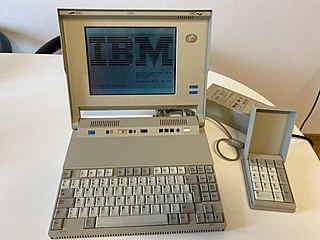
The IBM Personal System/2 Model L40 SX is a portable computer made by IBM as part of the IBM PS/2 series. It was the successor to the IBM PC Convertible. The "SX" in the name refers to its CPU, the Intel 80386SX.

The IBM ThinkPad 365 is a notebook computer series developed by IBM and manufactured by ASE Group. It was released in North America in November 1995, and was the successor of the ThinkPad 360 series. The series had 8 models that were released before being discontinued, and was succeeded in 1997 by the ThinkPad 380 series.

The IBM ThinkPad 700 is the first notebook computer for the ThinkPad brand that was released by IBM on October 5, 1992. Another series was released alongside it, the ThinkPad 300 series. The 300 series was meant to be a cheaper, lower performance model line over the 700. It was developed as a successor to the L40SX.
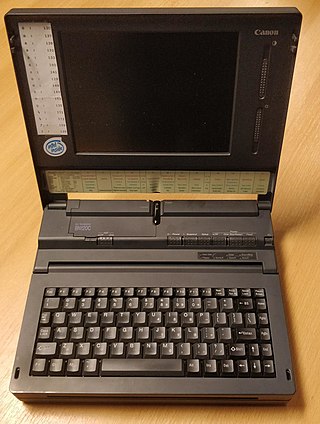
The Canon NoteJet is a series of notebook computers which include a printer and scanner that was manufactured from 1993 to 1995 by a joint venture between the Canon subsidiary Canon Computer Systems Inc. and IBM subsidiary IBM Japan. The Canon branded series was sold worldwide except in Japan, where the similar IBM ThinkPad 555BJ and 550BJ was sold. The European model did not use the NoteJet branding and was branded as the Canon BN120C, BN22 or BN200.
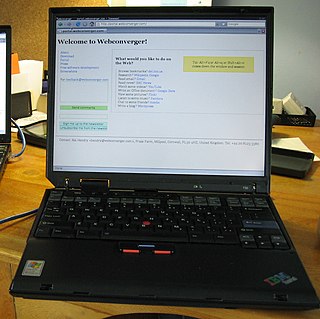
The IBM ThinkPad T30 is a laptop computer manufactured by IBM.

The LTE Elite was a series of notebook-sized laptops under the LTE line manufactured by Compaq from 1994 to 1996. All laptops in the LTE Elite range sported Intel's i486 processors, from the 40 MHz DX2 to the 75 MHz DX4. The LTE Elite was the first notebook-sized laptop to house the AC adapter inside the case itself, eliminating the need to carry an external power brick. The LTE Elite line was replaced by the LTE 5000 series in 1995. Compaq ceased manufacturing the LTE Elite line in March 1996.


